Facility Dogs and Animal-Assisted Therapy
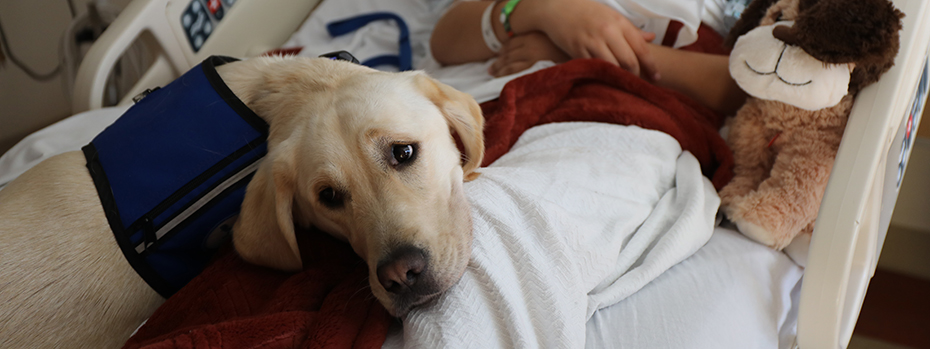
At OHSU Doernbecher Children’s Hospital, we understand the healing power of dogs and cats. Our animal-assisted therapy services are just one way we provide complete care for your child and family.
- Our hospital facility dogs, Casey and Darby, provide comfort and promote healing. They make being in the hospital less scary for young patients so we can provide the best care possible.
- They play an important role in supporting siblings and families.
- Separate animal-assisted therapy teams bring dogs and cats to visit patients at Doernbecher and other parts of OHSU.
How do animals help?
Studies show that therapy dogs can:
- Lower stress
- Distract a child from pain
- Ease a child’s fear of medical procedures
- Make a child happier and more relaxed
- Improve communication within families
- Improve communication between family members and care providers
At Doernbecher, therapy dogs make the hospital feel less frightening. This helps our expert doctors, nurses and other providers give children the tests and treatments they need with less stress.
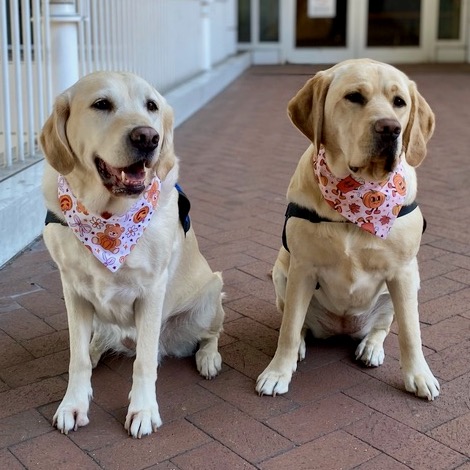
What are hospital facility dogs?
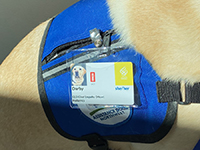
Hospital facility dogs are trained hospital therapy dogs. They respond to commands such as “snuggle” and "high-five." Casey and Darby are part of our staff, each with a vest and badge. They live with and report to work with OHSU employees who have received training and certification in animal-assisted therapy.
Our facility dogs are provided by Assistance Dogs Northwest. The nonprofit owns the dogs and partners with OHSU to offer their services.
Casey and Darby don’t visit patients with compromised immune systems or families who prefer not to be around dogs. Handlers also follow detailed policies on cleanliness for dogs, patients and patient beds.
Doernbecher began its facility dog program in 2015. Hope, the first dog to join, retired in 2022. Davis was a facility dog from 2018 to 2025.
What are animal-assisted therapy teams?
Volunteers bring therapy-certified dogs and cats to our Marquam Hill campus and other parts of OHSU. The volunteer-and-pet teams visit patient rooms and waiting areas at Doernbecher and OHSU Hospital.
Meet Casey and Darby
Casey and Darby are specially trained to bring joy and comfort to young patients. In patient rooms, they can lie next to a child for petting. Off-hours, they live with their handlers and caretakers.
The Casey file

Handlers: Nikki Wiggins, a nurse manager in Doernbecher’s Neonatal Intensive Care Unit, and Lyndsey Clapier, a clinical social worker in Doernbecher’s Pediatric Intermediate Care Unit
Breed: Labrador-golden retriever mix
Joined OHSU: 2022
Title: “Chief cuddling officer”
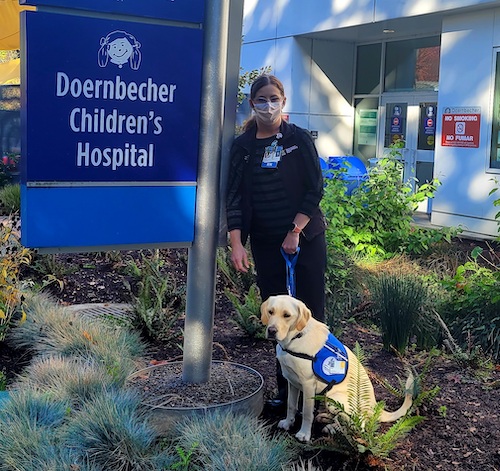
Role in therapy: Casey visits children in the hospital. She spends time with families of some of OHSU’s youngest patients, who might be in the Neonatal Intensive Care Unit for months. She snuggles with new parents in the Mother-Baby Unit. She also offers comfort to families who have had a loss in childbirth.
Special moments: One patient was on bed rest while pregnant with twins. After a visit from Casey, she felt a sense of calm and peace that lowered her anxiety and blood pressure. Another patient needed sedation for scans. Then she lay with Casey and petted and talked to her. The girl’s mom said Casey’s help meant the world to both of them.
Quotable: Casey helps families going through tough times. “She’s already touched so many lives in the short time that she has been at Doernbecher,” Wiggins says.
The Darby file
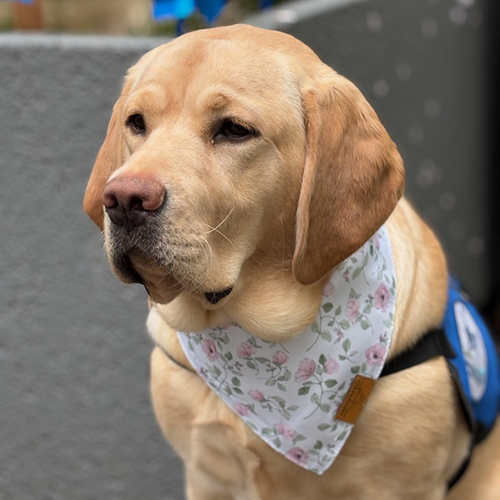
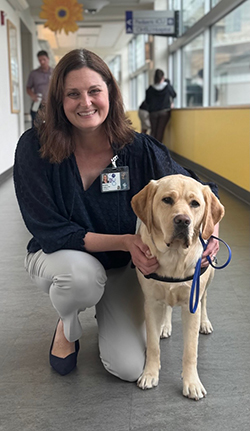
Handlers: Kristin Knight, a licensed clinical social worker in Doernbecher’s Pediatric Intensive Care Unit, and Dr. Dana Braner, Doernbecher’s physician-in-chief.
Breed: Labrador-golden retriever mix
Joined OHSU: 2025
Title: “Chief empathy officer”
Role in therapy: Darby visits patients and their families in Doernbecher’s Pediatric Intensive Care Unit, providing support, comfort, encouragement and snuggles while promoting healing.
Special moments: Darby was introduced to a school-age patient who was struggling to cope with coming to the hospital. After their visit, the patient shared: “Being able to snuggle with Darby makes being in the hospital OK.” Another patient said: “Darby’s soft fur and cuddles make things less scary and uncomfortable.”
Quotable: “From smiles to snuggles, Darby’s impact on our patients and families is immeasurable,” Knight says. “We are so appreciative that our hospital and community support this extra offering of support. “
Animal-assisted therapy teams
Volunteers bring dogs and cats with therapy certification to visit OHSU, including Doernbecher Children's Hospital. The pets snuggle with patients and go person to person in waiting rooms.
How the program works
To participate, pets must have a “complex” rating from Pet Partners, DoveLewis animal hospital or an equivalent organization. The certification, renewed each year, ensures the pet has been trained and can handle a busy hospital.
Volunteers agree to visit OHSU at least every other week. Veteran volunteers make sure teams are a good fit before they’re added to the roster.
Request a visit
Talk to your child’s care team if you’re interested in a visit from Casey, Darby or a pet-assisted therapy team. Doctors can prescribe a visit. Nurses also can arrange one.
Volunteering
OHSU can accept more animal-assisted therapy teams. To apply, your pet must have a “complex” rating from Pet Partners, Dove Lewis or an equivalent organization. Learn about: